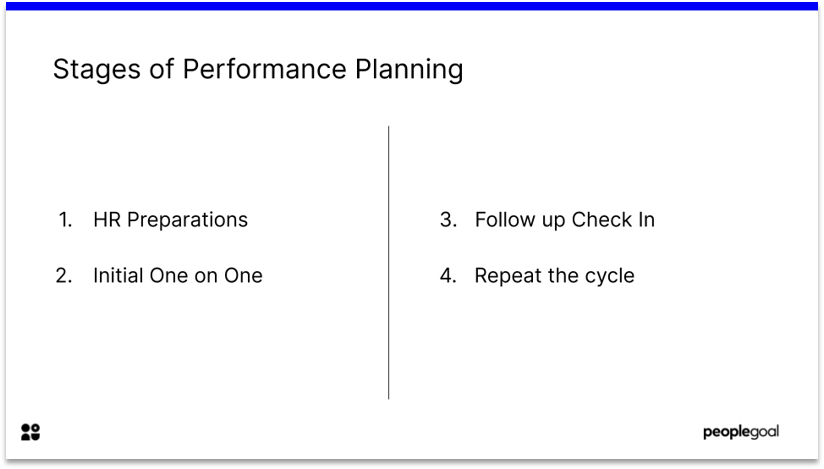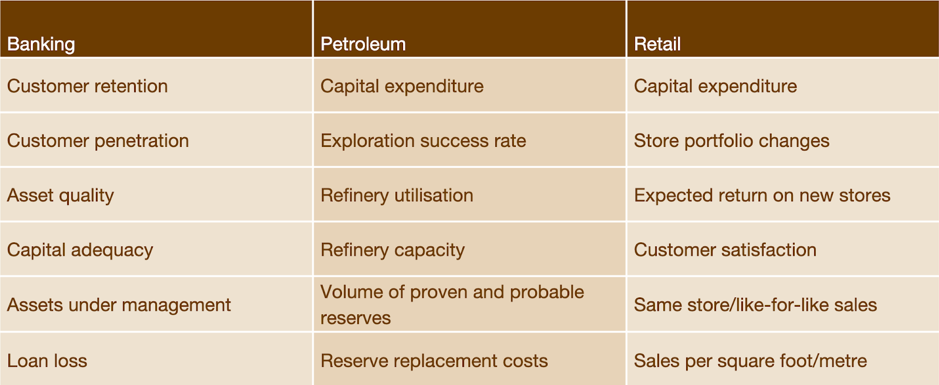Performance planning is a great HR tool to inspire employees to improve.
What is performance planning?
Performance planning is the first step to great performance management. It provides employees with a structured process to set and meet goals. A performance action plan is a roadmap for your teams’ development.
Goals and targets should be reviewed continuously. It helps an organization to understand if it has improved performance.
It can also refer to OKRs – objectives and key results, set for company-wide targets. Performance planning is used in any circumstance where individuals, departments or teams collaborate to accomplish a result.

What are the objectives of performance planning?
- Make targets realistic
- Keep teams accountable for their goals
- Set personal development plan
- Set company-wide development plan – what key results are teams working towards?
- Clarify competencies required – and where learning and development can fill skill gaps
Tips for Great Performance planning
Check Ins
Have a one on one to discuss an employee’s performance. An open-ended discussion helps pin-point areas for improvement.
Invite questions. Employees should feel empowered to ask for assistance in specific areas.
Different situations need different plans. Make sure your meeting is evidence-based – cite specific instances of great performance or areas for improvement. Events help ground the discussion, which makes feedback clearer.
Check-Ins provide an opportunity for informal feedback – both for employees and managers. Ongoing feedback is crucial to performance planning – remember that plans need to be reviewed and edited where relevant.

Quantify the areas for improvement
Key to improving performance is measuring progress. HR need to put goals into quantifiable terms.
For instance, if your employee needs to raise their outbound sales, they should to know by how much, so set 10% as a target.
“Soft skills” can also be measured. If an employee does not ask enough questions during a qualification call, set a target that they ask 10 questions each call.
This makes behaviors – and the steps to improve them – measurable.
Make it timebound and achievable
Give targets a deadline, and make sure that your employee is crystal clear on when this is.
Break down the larger goals into smaller goals. In Harvard Business Review, Sabina Nawaz warns against big goals that are unrealistic: ‘Falling short of a lofty goal creates a negative spiral of discouragement deterring future action’.
If we want to motivate employees, we need to take a micro perspective – what habits could be changed a little bit every day – to improve longer-term.
Tips for setting goals that stick:
- Set meaningful goals that align with your values
- Create a daily routine that fits around your goal – e.g. ‘I will let emails wait till after 12pm as I work best on my creative project in the morning’
- Word goals specifically – e.g. rather than ‘I will complete tasks more quickly’, instead ‘I will use time-blocking to carefully manage my time next week’
- Timebound- we work best towards goals when there is an end in sight!

Ask what assistance the organization can provide
You may need to provide extra training and learning to employees. Employees may lack resources.
Communicate your performance planning strategy to all levels of the company – and ensure managerial and executive buy-in. This means you’re more likely to have a budget to meet employee development needs.
Be Transparent
Being honest with your employees is vital. How will working in line with a career development plan be recognized? What will happen if the plan’s standards aren’t met?
Is there a possibility for promotion? Is a termination of employment on the cards?
Be careful to only bring termination up where there is a clear risk this will happen. Remember this can cause significant stress, and employees may lose confidence.
Transparency also involves honest, open feedback. Make sure conversations are empathetic wherever possible.
Engage in conversation about what the employee seeks in their career
Personal improvement plans (PIPs) should provide a chance for employees to reflect on what they really value in their career.
Here are some questions to help the employee reflect on what motivates them:
- Are there any skills you have always wanted to develop?
- Do any of our learning and development programs interest you?
- What makes you get up for work every morning?
- Where do you want to be in five years time?
- Why did you go into this industry?
- What values do you live and work by?

Provide regular 360 feedback
360° feedback is a process of feedback where the employee is rated by members of their organization, across all levels of seniority.
The goal is to get a well-rounded perspective on performance.
Benefits of 360 Feedback
- Outcomes more likely to benefit all company levels – as all have a say
- Manager feedback can aid development plans
- More touch-points accounted for – e.g. peer reviews help with insights on teamwork
- Self-assessment means self-reflection – crucial to investment in personal development plan
Steps of performance planning and review
1) HR Team briefing for performance planning
- Are there any skill gaps)?
- Review OKRs – and the values attached to them
- HR contacts the employee before the Performance Planning session and invites them to write a rough self-assessment and overall goal.
- Review previous performance reviews. Look over employee’s job specification and any competencies
2) Initial session
- Discuss key areas for improvement and create techniques for success. Set a deadline to enact a goal – for example, ‘Over the course of next week, I will share my project at regular intervals through Google Docs to ensure team members can offer comments’.
- Make sure goal setting is realistic, as celebrating small wins boosts motivation.
- Set SMART objectives (Specific, Measurable, Achievable, Realistic and Timely)
- Create a performance planning review form that allows them to reflect on the experience – so HR can improve its processes!
3) Follow up check-in
- Review how the employee performed that week/month/ 3 months in relation to their performance plan.
- Employee should speak for most of the meeting – HR invites/asks questions
- Allow employee to reflect on the process – what techniques worked, and what didn’t – ensure that you note all of this information down (e.g. through software)
- Review SMART targets or SWOT analysis – is anything no longer relevant, require editing?
- Recognize accomplishments!
4) Repeat the cycle
Performance planning is an ongoing process if you want employees to develop their skills.

How to use create a team improvement plan
Performance planning is not only about how we motivate ourselves. It can also be beneficial for teams.
Team development plans can help foster common purpose.
Some guiding principles for team performance plans:
- How can teams make use of technology to communicate more effectively, e.g. through Slack or Microsoft Teams?
- What are team-members individual skills – how can they optimize task-setting with this in mind?
- Invite team members to be honest (not self-deprecating) about their strengths and weaknesses
- Are there any skills gaps within the team?
- Discuss areas of success or failure – and set SMART goals in line with this
- Are there any important team projects upcoming? How can SMART targets be applied to these?
- Conduct a SWOT Analysis (Strengths, Weaknesses, Opportunities, Threats). Opportunities and Threats help to make performance planning future-oriented.
- Are there any challenges that will be faced in the coming year? What opportunities are there to tackle these issues?
Performance planning and reviews – how to integrate them
Many employees find performance reviews demotivating. The benefit of a Performance Improvement Plan or development plan is that it inspires employees to think positively about reviews.
Following a formal performance review, schedule a one on one in which to create a performance development plan. This is a chance for employees to vocalize their response to reviews, and for HR to receive informal feedback on the process.
Developing a plan requires a shared effort between HR or managers and employees – employees should have equal input.
Inspire a positive attitude by showing that improvement is possible, with the
correct action.
How performance planning supports remote workers
It’s no secret that since the pandemic, performance reviews have looked very unappealing. Google suspended performance reviews for 2020, along with many other major companies. According to Gallup, a meager 14% of employees said they ‘strongly agree’ that performance reviews motivate them.
As we adapt to working from home, evaluation is at the back of our minds. However, feedback can support us through this time.
Any feedback for newly remote workers must be constructive. This is where performance planning really comes into its own – reminding employees that feedback can help us develop our skills. It offers them the tools to act on reviews – the ability to build on feedback is what makes it constructive.
Top Tips for Performance Plans for Remote Teams
- Create a strategy for managing caring responsibilities – e.g. consider flexible working hours
- Ensure they have the resources they need for WFH
- Encourage productive habits by setting regular, achievable goals
- Advise on maintaining work-life balance
- Design a personal development plan based upon the move to remote work
- Use a SWOT analysis – there are certainly ‘weaknesses’ and ‘threats’ from remote work!
- … But what might be its strengths and opportunities – it’s important to nurture a positive outlook.

Performance planning – the first steps to improve employees
Performance planning isn’t a one-and-done. We face challenges that compromise our performance – and new habits help us build our skills. HR can check the temperature among staff regularly – so it can create a strategy for improving employees and recognizing attainment.
This requires gathering a lot of information, on a regular basis. PeopleGoal can help you automate the review process, set reminders for one-on-ones and record targets set. Why not book a demo today to start planning for high performance?
Ready to 3x Your Teams' Performance?
Use the best performance management software to align goals, track progress, and boost employee engagement.





